Singer NO. 66 Instruction Manual
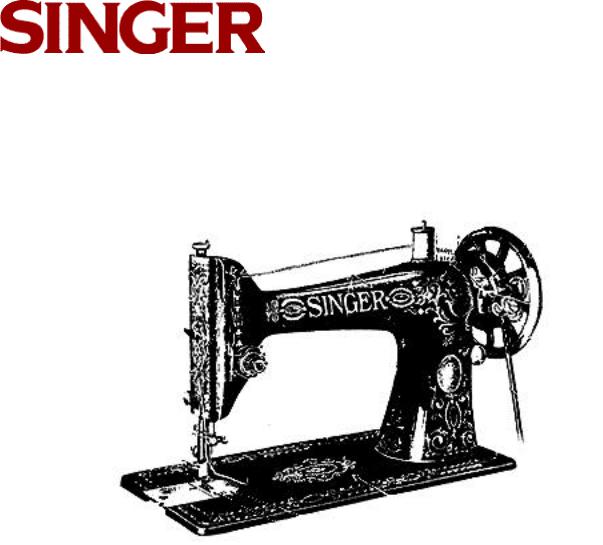
82387 No. 66
Singer Sewing Machine
No. 66
Oscillating Hook, For Family Use
INSTRUCTION MANUAL
Table of Contents |
| Next Page |

82387 No. 66
Table of Contents
Main Parts
Parts of the Machine Stand
Instructions for Operating the Machine
To Ensure Perfect Action of the Machine To Take Out the Bobbin
To Wind the Bobbin To Replace the Bobbin To Set the Needle
To Thread the Needle To Prepare for Sewing To Commence Sewing To Remove the Work Tensions
To Regulate Tensions To Turn a Corner
To Regulate the Length of Stitch
To Regulate the Pressure on the Material To Sew Flannel or Bias Seams
A Stitch to Ravel Easily To Oil the Machine
Hints
The Belt
Machine WOrking Heavily
To Avoid Breaking Needles
Breaking of Needle Thread
Breaking of Bobbin Thread
Skipping of Stitches
Attachments with the Machine
Instructions for Using the Attachments
Foot Hemmer
--Hemming
--Hemming and Sewing on Lace
--Felling
Adjustable Hemmer
--Hemming
--Wide Hemming
Binder -- Binding Bias Gauge
-- To Bind with Dress Braid Ruffling
Ruffler -- Ruffling Between Bands To Ruffle and Sew On
-- Five Stitch Ruffling or Paiting Ruffler with Shirring Plate -- Shirring Quilter
Tucker Under Braider
Embroidary and Darning
Relative Sizes of Needles and Thread
Previous Page | Next Page

82387 No. 66
Main Parts
Parts of the Machine Stand
A.BELT GUIDE
B.BAND WHEEL
C.BAND WHEEL CRANK
D.PITMAN
E.TREADLE
F.BELT SHIFTER
G.LEG
H.DRESS GUARD
Table of Contents |
Previous Page | Next Page |
3
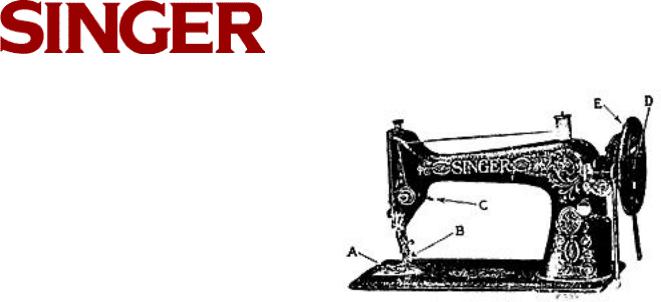
82387 No. 66
INSTRUCTIONS FOR
OPERATING THE MACHINE
Raise the presser foot (B. Fig. 3) by means of the presser bar lifter (C, Fig. 3) to prevent injury to the foot (B. Fig. 3) and feed (A, Fig.
.3).
It is necessary to understand the stop motion (D, Fig. 3) by which the balance wheel (E, Fig. 3) can be released when required, thus enabling the operator to become proficient in the use of the treadle and permitting the winding of bobbins without running the stitching mechanism. It also allows the operator to wind bobbins without removing partially sewn work and without unthreading the machine.
To release the balance wheel (E, Fig. 3) turn the stop motion screw (D, Fig. 3, page 3) over toward you. It may be necessary to hold the balance wheel while loosening the stop motion screw.
After releasing the balance wheel place your feet upon the treadle and with the right hand, turn the balance wheel over toward you. This will start the band wheel, treadle and pitman, the sewing mechanism having been disconnected.
FIG.3. FRONT VIEW OF THE MACHINE
Continue the motion thus begun by an alternate pressure of heel and toe, until a regular and easy movement is acquired, and the balance wheel kept in continuous rotation by use of the feet alone.
When you are thoroughly familiar with the treadle movement, and can restart the machine without turning the balance wheel in the wrong direction, tighten the stop motion screw to connect the balance wheel with the stitching mechanism.
Place a piece of cloth under the presser foot, let the foot down upon it, and operate the machine in this way without being threaded, until you have become accustomed to guiding the material.
Table of Contents |
Previous Page | Next Page |
4
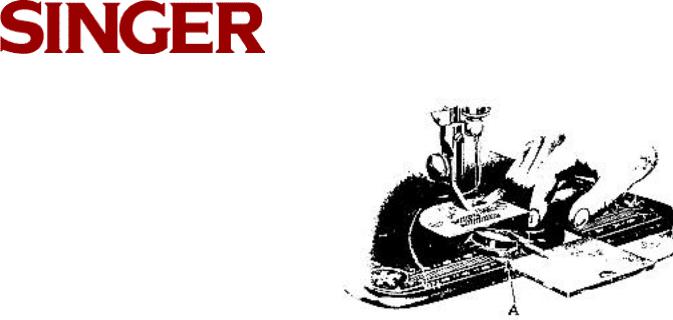
82387 No. 66
To Ensure Perfect Action of the Machine
The balance wheel must always turn over toward the operator.
Do not run the machine with the presser foot resting on the feed without cloth under the presser foot.
Do not run the machine when both bobbin case and needle are threaded unless there is material under the presser foot.
Do not try to help the machine by pulling the fabric lest you bend the needle. The machine feeds the work without assistance.
The slide over the bobbin case should be kept closed when the machine is in operation.
FIG. 4. REMOVING THE BOBBIN
To Take Out the Bobbin
Draw to the left the slide in the bed of the machine and press the forefinger of the right hand upon the bobbin ejected as shown above; this will raise the bobbin so that it can be easily taken out.
Table of Contents |
Previous Page | Next Page |
5
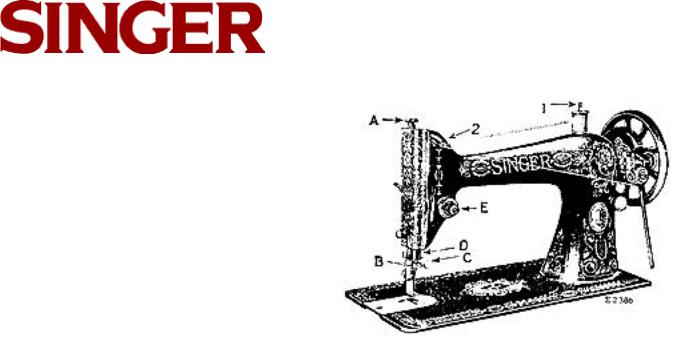
82387 No. 66
To Wind the Bobbin
Release the balance wheel (E, Fig. 3, page 3) by turning the stop motion screw (D, Fig. 3, page 3) over toward you.
Place the bobbin on the bobbin winder spindle (E, Fig. 6, page 7) and push it up closely against the shoulder, having the small pin in the spindle enter the hole in the side of the bobbin. Put the spool of thread on the spool pin (1, Fig. 5). Pass the end of the thread into the thread guide (2, Fig. 5) then up into the lower eyelet (3, Fig. 6) of the bobbin winder thread guide, into the notch (4, Fig. 6) and pass the thread through the hole in the left side of the bobbin (5, Fig. 6) from the inside. Press the bobbin winder pulley (B, FIG. 6) down on the balance wheel hub and the latch (C, Fig. 6) will drop down and hold it. Then operate the treadle the same as for sewing.
Table of Contents
FIG. 5. MACHINE THREADED
FOR WINDING THE BOBBIN
Previous Page | Next Page
6
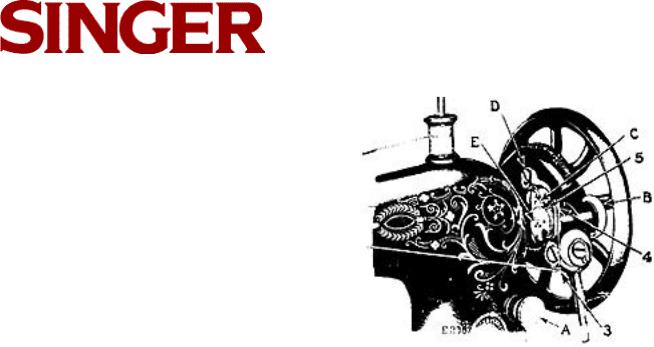
82387 No. 66
To Wind the Bobbin continued...
The end of the thread must be held by the hand unti1 a few coils are wound and should then be broken off. Figs. 5 and 6 show the bobbin winder properly threaded and in position for winding. When sufficient thread has been wound upon the bobbin it is automatically released from the stop latch (C, Fig. 6).
If the pressure of the rubber ring (B, Fig. 6) against the hub of the balance wheel is insufficient for winding the bobbin, loosen the adjusting screw (D, Fig. 6) and press the bobbin winder lightly until the rubber ring is in contact with the hub of the balance wheel; then tighten the screw.
Table of Contents
FIG. 6. WINDING THE BOBBIN
Previous Page | Next Page
7

82387 No. 66
To Replace the Bobbin
Hold the bobbin between the thumb and forefinger of the left hand, the thread leading on top from the right toward the left, as shown in Fig. 7.
Place the bobbin into the bobbin case and draw the thread into the slot (1, Fig. 8) in the bobbin case, as shown below.
Draw the thread backward between the bobbin case and the tension spring until it reaches the notch (2, Fig. 9) then pull the thread toward the right as shown in Fig. 9.
When closing the slide see that the thread is in the slot (3, Fig. 10) in the right edge of the slide, as shown below.
FIG. 7.REPLACING THE BOBBIN
FIG. 8. THREADING the BOBBIN CASE
FIG. 9. BOBBIN CASE THREADED
FIG. 10. UNDER THREADING COMPLETED
Table of Contents |
Previous Page | Next Page |
8

82387 No. 66
To Set the Needle
Turn the balance wheel over toward you until the needle bar moves up to its highest point in the sleeve (D, Fig. 5), loosen the thumb screw (C, Fig. 5) in the needle clamp (B. Fig. 5) and put the needle up into the clamp as far as it will go, with its flat side toward the right, then tighten the thumb screw.
To Thread the Needle
SEE FIG. 11
Turn the balance wheel over toward you until the thread take-up lever (5) is raised to its highest point. Place the spool of thread on the spool pin at the top of the machine; lead the thread into the thread guide (1) at the left, down, under and from right to left between the tension discs (2), into the small wire spring (3), under the thread regulator (4) at the left (not through the eye in the thread regulator), up and from right to left through the hole in the end of the thread take-up lever (5), down into the eyelet (6), into the lower wire guide (7), then from left to right through the eye of the needle (8).
Draw about two inches of thread through the eye of the needle with which to commence sewing.
FIG. 11. THREADING THE NEEDLE
Instructions for threading the machine for darning and for embroidery are given on pages 34 and 35.
Table of Contents |
Previous Page | Next Page |
9
